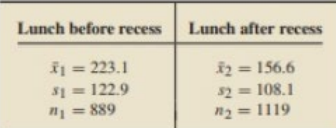Bergman et al. conducted a study to determine, among other things, the impact that scheduling recess before or after the lunch period has on wasted food for students in grades three through five. Results were published in the online article "The Relationship of Meal and Recess Schedules to Plate Waste in Elementary Schools" (Journal of Child Nutrition and Management, Vol. 28, Issue 2). Summary statistics for the amount of food wasted, in grams, by randomly selected students are presented in the following table.

At the significance level, do the data provide sufficient evidence to conclude that, in grades three through five, the mean amount of food wasted for lunches before recess exceeds that for lunches after recess?


